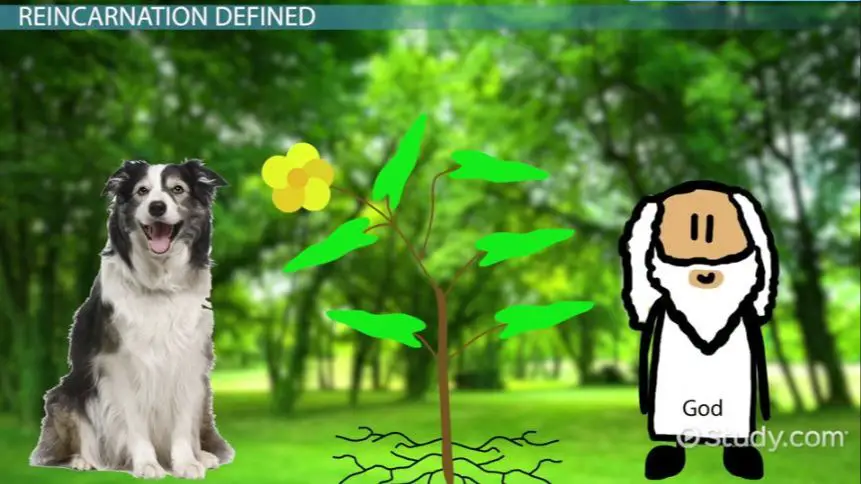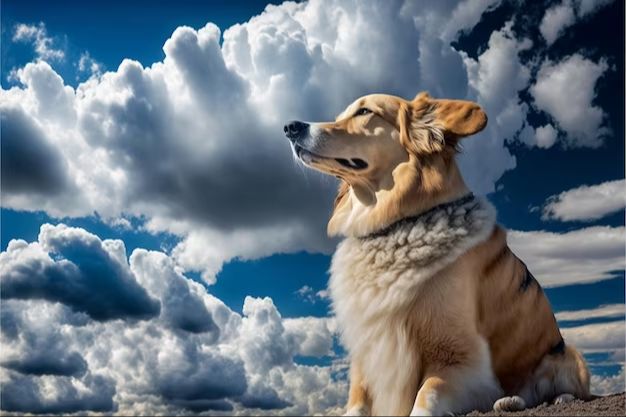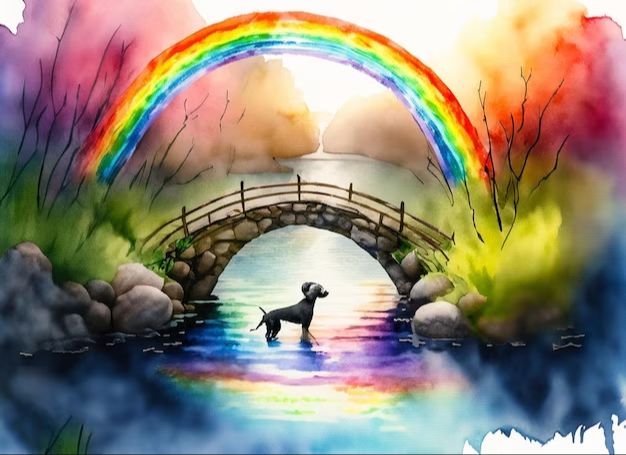Coping with the Loss of Your Beloved Dog
Losing a cherished canine companion is one of the most difficult experiences a pet owner can face. Our dogs are not just pets – they are members of the family. We build an incredibly close bond with our furry friends over the years. When that special soulmate passes away, it leaves an immense void in our lives and our hearts. The grief can feel overwhelming. Along with the sadness often comes an aching curiosity: where has my precious pup gone? Is there an afterlife for animals? Will I ever see my dog again?
This article aims to provide some comfort, reassurance and closure to dog owners who have lost their pet. We will explore various perspectives on where dogs go after death according to religious and spiritual beliefs, scientific theories, as well as real-life experiences and signs that provide hope we will reconnect with our canine companions over the Rainbow Bridge.
Religious and Cultural Beliefs
There are a variety of religious and cultural beliefs about where dogs go after they die. Here is an overview of some of the major perspectives:
In Christianity, there are differing viewpoints on whether animals like dogs have souls and an afterlife. Some believe dogs do not have souls, while others believe God cares for all of His creations and allows dogs entrance to Heaven. The Catholic church leaves it up to individual interpretation.
Hinduism and Buddhism both believe in reincarnation, where a being’s soul is reborn into a new body after death. This applies to dogs as well, who may be reincarnated as a dog or even as a human in their next life.

Islam teaches that animals like dogs lack an immortal soul. However, there are some stories in Islamic folklore about animals entering paradise and being rewarded for their service to humankind.
Ancient Egyptians sometimes mummified and buried dogs alongside their owners, believing the dogs could accompany them to the afterlife. In China, paper replicas of dogs were buried with the dead for this purpose.
Native American cultures often portrayed dogs guiding their owners’ souls across the afterlife. Some believed dogs waited for their owners before crossing over together.
The Rainbow Bridge poem is a popular cultural myth that dogs who die wait at a mythical bridge until their owners pass away and are reunited with them in Heaven.
Scientific Theories
When it comes to what happens to dogs after death, science takes an empirical approach based on evidence and skepticism. From a scientific viewpoint, there are a few possibilities that have been proposed:
Nothingness – Some scientists believe that death represents a permanent end to consciousness and subjective experience. Just as dogs were not aware before birth, they cease to be aware after death. Their remains simply decay and return to the environment.
Dissipation – Another scientific perspective is that the energy and particles that make up a dog’s being ultimately dissipate back into the universe and mix with other forms of matter and energy. While the dog’s identity ceases, the atoms that composed its body live on and become parts of new systems.
Soul Debate – Scientists have differing views on whether dogs have a “soul” or consciousness that could exist beyond death. Since this concept is metaphysical and untestable, it remains debated. Overall, science does not definitively conclude where a dog’s subjective experience goes after death.
Near Death Experiences
Some dog owners report witnessing near death experiences with their beloved pets. These anecdotal accounts describe dogs being revived after their hearts stopped or breathing ceased, only to later exhibit strange behaviors potentially implying an encounter with an afterlife.
In one widely-shared story, a dog owner tearfully performed CPR on her drowned Pomeranian and eventually managed to revive her. The owner was astonished when the dog suddenly looked up at a previously empty corner of the room and began wagging her tail as if seeing an invisible presence. Skeptics suggest the dog may have simply been delirious or confused after her trauma, but believers wonder if she was interacting with a spirit or angelic guide that greeted her in the afterlife before sending her back.
Other pet owners describe dogs who miraculously recovered from lethal health conditions, only to later howl or stare intently at seemingly empty spaces. Some claim their dogs acted as if they could see and play with deceased companion animals who had passed on earlier. While intriguing, these accounts are difficult to independently verify and rest heavily on subjective interpretations of canine behavior.

Overall, near death experience stories can offer comfort to grieving owners seeking hope. However, they provide limited scientific evidence of where our beloved dogs go after they die. Careful assessment of the source and quality of these anecdotes is needed when evaluating claims about dogs’ experiences at the end of life.
Communication with Passed Dogs
Some people believe it’s possible to communicate with dogs who have passed away and make contact with their spirit. Mediums and pet psychics claim to have the ability to connect with dead pets and relay messages from beyond.
Alleged methods of communicating with passed pets include:
- Pet mediums – individuals who claim to communicate with dead pets through extrasensory perception.
- Animal communicators – people who say they can telepathically connect with living and dead animals.
- Dream visitations – dreams involving vivid encounters with a deceased pet.
- Signs and symbols – interpreting events, sights, or sensations as messages from a passed dog.
- Electronic voice phenomena – capturing unexplained voices of dead pets on audio recordings.
There is no scientific evidence to confirm the validity of communicating with deceased pets. Skeptics suggest apparent messages may be the result of the medium’s own imagination, fantasy, or intentional deception. Some see communicating with dead dogs as providing comfort, while others view it as preying on grieving pet owners.
Signs from Passed Dogs
Many pet owners who have lost a cherished dog report seeing signs that their deceased companion is still with them in spirit. These perceived signs can provide comfort and a sense of ongoing connection after a pet’s passing.
Some common examples of behaviors thought to be signs from passed dogs include:
- Hearing familiar sounds like barking, tags jingling, or scratching at the door
- Spotting your dog’s face or shape in cloud formations
- Feeling a weight on the bed where your dog used to sleep
- Catching a brief glimpse or vision of your deceased pet
- Noticing items knocked over or moved from familiar places
- Having a dream about your dog alive and healthy
- Smelling your dog’s scent around the house
- Seeing signs and omens on significant dates like your dog’s birthday

People often look for patterns and meaning in these signs. For example, some think hearing barking or scratching occurs when their deceased pet wants attention. Seeing cloud shapes may signal their spirit is watching over them. Smelling their scent may indicate they are making an otherworldly visit. While there are scientific explanations for some of these phenomena, the perceived meaning can provide comfort.
Noticing behaviors believed to be signs from a passed dog is a common part of grieving and missing a beloved companion. Being open to potential signs allows people to feel an ongoing connection. However, it’s important not to become preoccupied or distressed if hoping for more signs than appear. Focus instead on cherished memories.
Pet Bereavement and Coping
Losing a beloved dog is one of the most difficult experiences a pet owner can face. The grief over losing your furry best friend can be intense and long lasting. It’s important to allow yourself to fully feel the pain of loss and mourn the death of your pet.
Here are some tips for coping with pet bereavement:
- Allow yourself to fully grieve – Give yourself time and space to cry, feel sad, and process the loss. Don’t feel rushed to “get over it”.
- Talk about your feelings – Share stories and memories of your dog with friends, family, other pet owners. This can help with grieving.
- Create a memorial – Hold a funeral, make a photo album or frame your favorite picture to remember your dog.
- Take care of yourself – Make sure to eat well, exercise, and rest during this difficult time.
- Consider a pet loss support group – Connecting with others who have lost pets can help you feel less alone.
- Cherish the good memories – Reflect on the joy, fun, and unconditional love you shared with your dog.
- Do something meaningful – Volunteer at a shelter, make a donation in your dog’s name, plant a tree to represent their life.
Losing a pet is painful but being able to have closure through memorials and talking through your grief can help the healing process. Focus on all the happiness you gave your dog while they were alive.
Celebrating Your Dog’s Life
After a beloved dog passes away, it may be therapeutic to put your cherished memories into a tangible form such as a photo album, scrapbook, or physical memorial. Looking at old pictures of happy times with your dog, like when they were a playful puppy, or when you took them on fun vacations, can help heal the pain of loss. Putting together a collection of your dog’s photos, favorite toys, leash, and other personal effects can be a wonderful way to celebrate and honor their life.
You may want to make a scrapbook or memory book containing photos that highlight your dog’s quirky personality, their silly antics, and your fondest memories. Design printed pages with captions, decorative borders, and your dog’s name. Slip in items like your dog’s ID tag, a tuft of their fur, or plaster paw print as mementos. Looking through this memory book can reassure you that although your dog may be gone, the special bond and happiness you shared will live on.
Some pet owners create simple memorials in their home or yard, like a stepping stone engraved with their dog’s name, urn for ashes, framed photo, or small plaque. You may plant a tree or your dog’s favorite flowers and visit it when you need comfort. Do what feels meaningful – your dog was a beloved family member, so honor them in any way that helps your grieving process. By celebrating your dog’s life and legacy, their spirit will continue bringing you joy.
Seeking a New Dog
For many dog owners, losing their canine companion leaves a huge void in their life. The unconditional love, companionship and daily routines with a dog are not easily replaced. While the grief process takes time and each person heals differently, eventually many dog owners start to ponder getting a new dog.
There’s no set timeframe for when to get a new dog after losing one. Some people may feel ready after just a few weeks or months, while for others it could take many months or even years before they feel emotionally prepared. It’s important not to rush into getting a new dog before you’ve sufficiently worked through the grief process.
Give yourself enough time to mourn the loss and honor the memory of your previous dog before considering a new adoption. Avoid pressuring yourself to “replace” your dog too soon. Your grief may come in waves, and a new dog deserves your full love and attention when you’re ready.
Look for signs within yourself that you’ve reached acceptance of your dog’s passing, such as being able to talk about your dog without acute sadness or enjoy looking at old photos. When happy memories bring more smiles than tears, it may indicate healing.
Before adopting, consider if your lifestyle and household status has changed since your last dog. Do you still have the time, energy and resources to properly care for a new dog? A new dog should match your current situation.
It also helps to honor your previous dog’s memory even after adopting a new dog. You can cherish both relationships. The new dog won’t replace the one you lost, but instead create new joyful memories.
The Rainbow Bridge
The Rainbow Bridge is a heartwarming poem and concept that provides comfort for those grieving the loss of a pet. It imagines a beautiful place where our passed companion animals wait for us until we can be reunited.

The poem describes a meadow with lush green grass and warm sunshine, where all our beloved pets who have passed away come to run and play together as they wait for us. Their spirits feel young and healthy once more. There is no sadness or suffering, only joyful anticipation of the day when we will cross over the Rainbow Bridge together.
For those missing their passed dog and longing to see them again, imagining this idyllic place can provide great comfort. Though a fantasy, picturing our dog happy, active, and carefree as they wait to greet us can help ease the pain of loss. The Rainbow Bridge reminds us our bond and love for our dog transcends physical death. We will meet again and continue our journey together.
The Rainbow Bridge is a touching metaphor about the power of love. For dog owners working through grief, it offers reassurance of an eventual reunion, even if only in spirit. It reminds us the love we share with our dogs is eternal and will continue to comfort us until we meet again.
